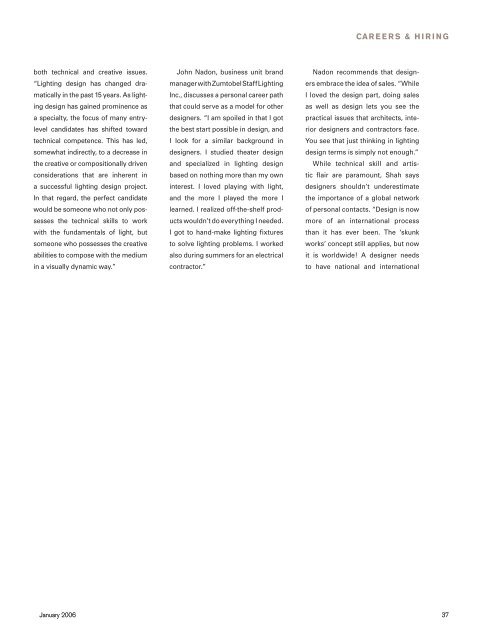COMMeMOratiVe ISSue - Illuminating Engineering Society
COMMeMOratiVe ISSue - Illuminating Engineering Society
COMMeMOratiVe ISSue - Illuminating Engineering Society
Create successful ePaper yourself
Turn your PDF publications into a flip-book with our unique Google optimized e-Paper software.
CA R E E R S & H I R I N G<br />
both technical and creative issues.<br />
“Lighting design has changed dramatically<br />
in the past 15 years. As lighting<br />
design has gained prominence as<br />
a specialty, the focus of many entrylevel<br />
candidates has shifted toward<br />
technical competence. This has led,<br />
somewhat indirectly, to a decrease in<br />
the creative or compositionally driven<br />
considerations that are inherent in<br />
a successful lighting design project.<br />
In that regard, the perfect candidate<br />
would be someone who not only possesses<br />
the technical skills to work<br />
with the fundamentals of light, but<br />
someone who possesses the creative<br />
abilities to compose with the medium<br />
in a visually dynamic way.”<br />
John Nadon, business unit brand<br />
manager with Zumtobel Staff Lighting<br />
Inc., discusses a personal career path<br />
that could serve as a model for other<br />
designers. “I am spoiled in that I got<br />
the best start possible in design, and<br />
I look for a similar background in<br />
designers. I studied theater design<br />
and specialized in lighting design<br />
based on nothing more than my own<br />
interest. I loved playing with light,<br />
and the more I played the more I<br />
learned. I realized off-the-shelf products<br />
wouldn’t do everything I needed.<br />
I got to hand-make lighting fixtures<br />
to solve lighting problems. I worked<br />
also during summers for an electrical<br />
contractor.”<br />
Nadon recommends that designers<br />
embrace the idea of sales. “While<br />
I loved the design part, doing sales<br />
as well as design lets you see the<br />
practical issues that architects, interior<br />
designers and contractors face.<br />
You see that just thinking in lighting<br />
design terms is simply not enough.”<br />
While technical skill and artistic<br />
flair are paramount, Shah says<br />
designers shouldn’t underestimate<br />
the importance of a global network<br />
of personal contacts. “Design is now<br />
more of an international process<br />
than it has ever been. The ‘skunk<br />
works’ concept still applies, but now<br />
it is worldwide! A designer needs<br />
to have national and international<br />
January 2006 37
















